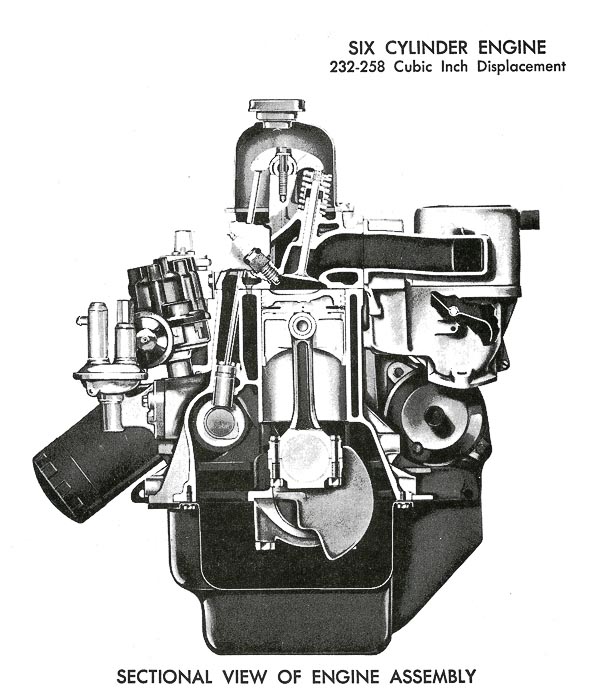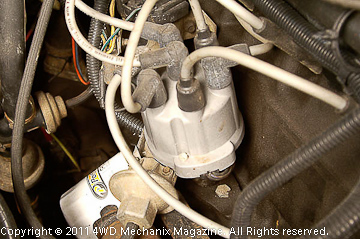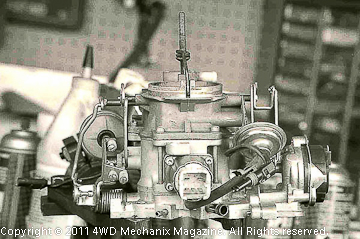The 4.2L/258 six found in Jeep CJs and many 1987-90 YJ models is a rugged, highly reliable engine. Seven main bearings and a fundamental pushrod OHV design distinguish this AMC powerplant. The 4.2L served as the platform and architecture for the 4.0L engine introduced in 1987 XJ/MJ models.

The 4.2L engine design dates to 1964, the family of AMC 199/232/258 and 242 (4.0L) cubic inch engines that survive as the 4.0L through the TJ era. 4.2L engine applications, dating back to 1971, are essentially the same from 1981-90, with distinctions surrounding Federal 49-State versus California models—mostly tuning and the required devices to curb tailpipe emissions.
Later 4.2L engines have a Carter BBD carburetor and conventional ignition distributor. The distributor and spark wiring is familiar and easy to service. This electronic distributor uses a rotor and distributor cap—each requires periodic replacement. Spark plugs and spark wires are replaced in routine fashion. Engine misfire, poor fuel efficiency and lack of power can result when basic maintenance is neglected.
The 4.2L distributor also features a vacuum canister. This is the last Jeep six-cylinder ignition to use a vacuum advance mechanism in conjunction with a mechanical/centrifugal advance unit within the distributor. When spark timing fails to meet engine needs, a faulty vacuum canister or sticky centrifugal weights and springs can be the cause.

You can check advance unit performance with a conventional timing light and simple vacuum pump. With the vacuum advance hose disconnected and taped, hold the timing light on the timing mark while increasing the engine speed. The centrifugal spark advance unit should show a steady timing advance to 2000 crankshaft rpm. (Caution: Stay safely away from the fan and do not exceed 2000 rpm during this test.)
To test the vacuum advance, turn the engine off and disconnect the three-wire connector at the 4- and 10-in/hg switches on CEC systems. (See the underhood emission decal for CEC information.) Hook a hand vacuum pump to the vacuum canister on the distributor. With the engine at an idle, apply vacuum to the canister. There should be smooth timing advance at the marks on the crankshaft damper and a noticeable increase in engine speed as you increase the vacuum supply. The vacuum should hold steadily if the diaphragm is in good condition.
The ignition should work well if spark plugs are clean and gapped properly, the spark plug wires, conventional coil, cap and rotor are in good shape and the distributor advance mechanisms function properly. The spark wires and coil can be readily tested for ohms resistance readings.
If all components test okay, the other devices associated with ignition performance include the ignition module (a common source of trouble on these Motorcraft ignitions), the MCU (microcomputer unit) and an array of emission control devices with solenoid and vacuum sources.
In an effort to “fix” the emission control and computer elements of the 4.2L engine, many owners and shops attempt to disconnect these devices—either some or all of them. In addition to violating Federal and State emission control laws in the process, attempts to disconnect devices generally result in an engine that runs poorly and worse than it did in its showroom stock form.
During the early YJ Wrangler era, I had the good fortune to test many YJs with 4.2L engines. I drove over the Rubicon Trail and at high altitude venues and rugged backcountry. These engines ran well with their stock ignition and fuel delivery systems. For that reason, I have always held the belief that a properly restored YJ 4.2L engine will run quite well and provide excellent service.
Although the Mopar Performance MPI conversion is a major improvement over the restrictive carburetor and conventional distributor of a 4.2L six, many owners will benefit from simply restoring the stock components and meeting this engine’s original equipment standards.
If simple ignition service and a fresh air cleaner and PCV valve do not bring the 4.2L engine into tune, there are three other possibilities: 1) the engine may have significant wear, 2) the emission and/or vapor system devices may not be working properly or 3) the carburetor is malfunctioning.
Use factory diagrams to troubleshoot vacuum and emission switch circuits on your Jeep chassis and engine. Perhaps devices have failed or were eliminated by a former owner. Restore the system if you intend to keep the original carburetion, induction, emissions and ignition systems.
If you can, with certainty, narrow the problem to the Carter BBD carburetor, value this carburetor. The BBD took us over trail obstacles, high passes and muddy bogs. It can do so again if rebuilt to factory, “blueprint” standards. Toward that end, I have covered the BBD carburetor rebuild in the CJ and YJ Wrangler Workshop sections of the magazine. If you have a copy of my Jeep CJ Rebuilder’s Manual: 1972-86, you will find more in-depth BBD details.

‘MCU’ and Feedback Devices
The Micro Computer Unit (MCU) is constantly reading engine functions. On BBD carbureted models that have the MCU, this microprocessor receives a host of signals from various engine-sensing devices. The MCU with a closed-loop, feedback carburetor provides the closest technology to EFI. In 1991, after years of CJ and YJ 4.2L engines with BBD feedback carburetors, the Wrangler switched to the 4.0L MPI/EFI powerplant.
Late CJs and the YJ 4.2L engines equipped with BBD carburetion depend upon the MCU and thirteen sensing devices. To assure proper engine performance, consider these devices:
1) The coolant temperature switch
2) The thermal electric switch
3) 4- and 10-inch/height vacuum switches
4) An oxygen sensor
5) The Wide Open Throttle (WOT) Switch
6) A Closed Throttle Switch (only on four-cylinder models—without the BBD carburetor)
7) A knock (detonation/ping) sensor
8) The ignition distributor
9) Mixture Control Solenoid (“Stepper Motor”)
10) Idle relay
11) Sole-Vac Throttle Positioner
12) Gangs of upstream and downstream solenoids
13) The PCV solenoid
Add to this the vacuum hoses and electrical wiring that support these devices. The thermal air cleaner is an emission device in itself. So is the evaporative emissions system, which ranges from the fuel tank through the vapor canister to the carburetor. Each of these devices must interface properly with each other. Sub-systems must function reliably.

If you overhaul the carburetor with certainty that it should perform like new, and if the performance is still short of optimal, carefully consider and troubleshoot these other devices, hoses and electrical connectors. The BBD carburetor is only part of the 4.2L six’s interactive fuel-and-spark management system.
The carburetor overhaul depicted in this article turned a high mileage, stalling 4.2L engine into a dependable package. Compression being adequate and uniform, tuning was not a problem. Start-up is immediate, hot or cold. Cold start requires nothing more than stepping down on the gas pedal and releasing it (to set the choke) then cranking the engine. On warm restart, the engine fires with just a bump of the key.
Acceleration is impressive, the highway mileage has improved, and the engine is frisky for its 142,000 miles and overall condition. This was well worth the cost of a carburetor kit! Even the blow-by has slowed considerably, as the air/fuel ratios returned to normal, and the cylinders are no longer fuel washing.
While the Mopar MPI/EFI kit would clearly add more versatility and horsepower to any 4.2L engine, this 4.2L engine performs very well and will easily serve until engine overhaul time. At that point, an EFI/MPI conversion would be a sensible consideration.
